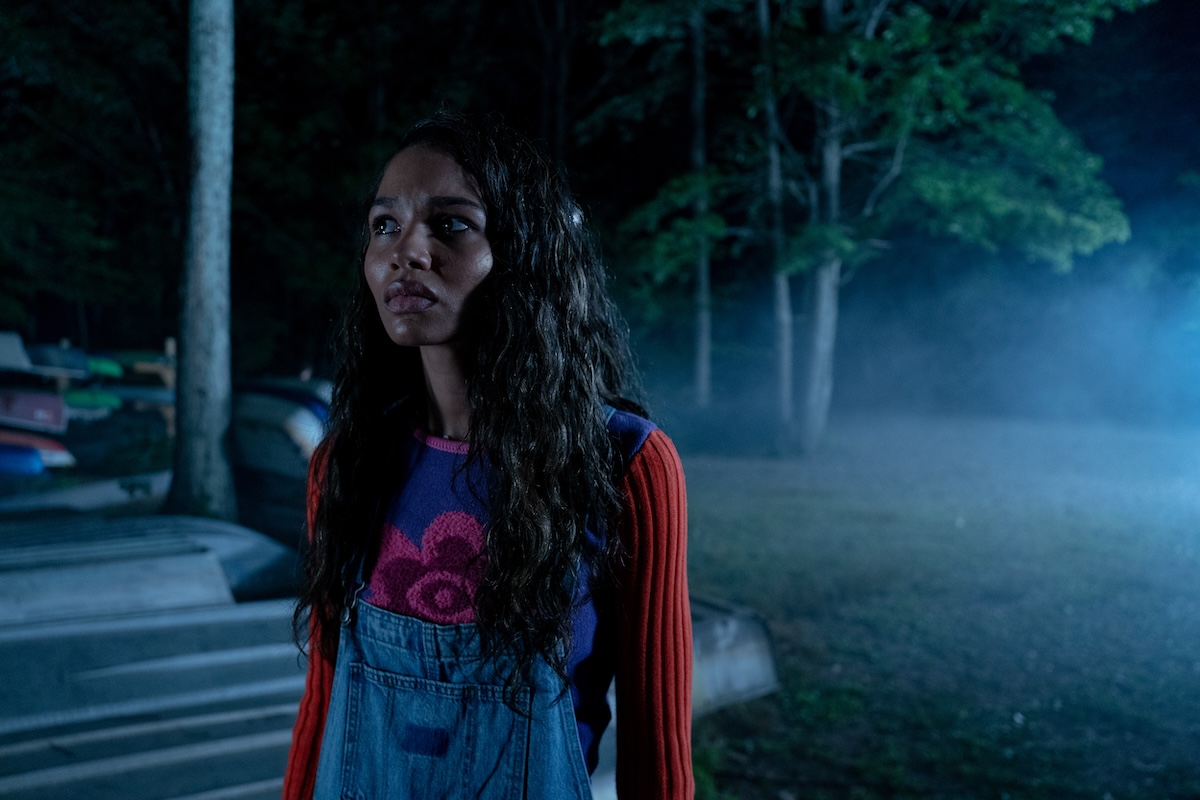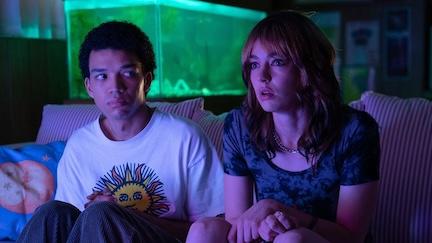There comes a point in I Saw the TV Glow when the repressed high-schooler Owen (Justice Smith) smashes his television’s screen by trying to dive into the box itself, to cross the great divide between his numbed reality and the feminine supernatural fantasy-land of his favourite series.
Bursting into the room, Owen’s brutish widowed father (Fred Durst) pulls him from the wreckage. The scene is a metaphor for gender dysphoric Owen’s inability to start transitioning into a girl, a block that will leave him emotionally crippled. That is the nub of Jane Schoenbrun’s dazzling second feature, not so much a coming of age drama as a drama about coming permanently undone at the critical point of maturation.
Filmed in dazzling day-glo colours, suggesting the iridescent shimmer of 1990s television screens, trans writer-director Schoenbrun’s film is an instant classic, a disquieting but non-judgmental post-modern psychothriller about the value and dangers of wholesale immersion in visual media and the complexities of trans self-identification. I Saw the TV Glow’s debts to the questing “feminine camera” of Olivier Assayas, to David Cronenberg’s Videodrome, and transparently to the haunted chambers, embedded nostalgia, and ethereal indie music of David Lynch's Twin Peaks – about which Schoenbrun dreamed – don’t compromise the film's originality.
In interviews, Schoenbrun, 37, refers to the trans term “the egg-crack” – the moment when the shell protecting a person from acknowledging their true gender identity breaks irrevocably. The show that transfixes Owen and his sullen queer friend Maddy (Brigette Lundy-Paine) is The Pink Opaque, inspired mostly by Buffy the Vampire Slayer (1997-2003), the queer-coded series that absorbed and inspired Schoenbrun before their egg cracked in 2019.
 Schoenbrun came out as trans in 2020 after completing their first feature We’re All Going to the World’s Fair, a You Tube-scavenged riff on the Internet as a dysphoric space in which reality and fantasy blur for a lonely teenager (Anna Cobb) participating in an online horror role-playing game.
Schoenbrun came out as trans in 2020 after completing their first feature We’re All Going to the World’s Fair, a You Tube-scavenged riff on the Internet as a dysphoric space in which reality and fantasy blur for a lonely teenager (Anna Cobb) participating in an online horror role-playing game.
Starting in 1996, when television was still the dominant medium for what Marshall McLuhan described as “electronic interdependence” and “superimposed coexistence”, I Saw the TV Glow is the second part of Schoenbrun’s planned “Screen Trilogy” (or “Self-Induced Hallucination Trilogy”) exploring the ramifications of the use, willed or unwitting, of screens as mirrors for psychological self-detection.
As a shy, nervous seventh-grader, Owen (played as a pre-pubescent 12- or 13-year-old by Ian Foreman) chances on ninth-grader Maddy poring over an episode guide to The Pink Opaque. She senses a secret sharer and disciple. Soon he is breaking the TV curfew set by his dad and his dying mom (Danielle Deadwyler) to sneak over to Maddy’s house to watch The Pink Opaque during illicit sleepovers; Maddy smuggles videocassettes of the show to him so he can catch up on the early seasons.
Watching Owen absorbed in the show, I thought of Steven Wilson’s lines from Porcupine Tree's song “Prodigal”: “I spend my days with all my friends/They're the ones on who my life depends/I'm gonna miss them when the series ends.” The spell encompassing Owen is catastrophically ruptured when the series is canceled. When he snatches a look at The Pink Opaque years later, he sees a cheesy kids’ show; the past is as much an unwatchable TV programme as a foreign country for which there is no passport.
In The Pink Opaque, psychically connected summer camp friends Isabel (Helena Howard, pictured above) and Tara (Lindsay Jordan) strive to defeat the “Monsters of the Week” sent to menace them by Mr. Melancholy, “the Big Bad”, a Lynchian bogeyman represented as a glowering Georges Méliès moon. Per Joseph Campbell, slaying the dragon of their egos is what Isabel and Tara are about. Mr. Melancholy seeks to trap them in "the Midnight Realm”, which translates for Owen and Maddy, who naturally identify with Isabel and Tara, as the living hell of developmental stasis.
The Mr. Melancholys in Owen and Maddy’s lives are their tyrannical fathers – Maddy’s, unseen, the serial abuser she escapes, causing her to disappear in the middle of the film, leaving Owen bereft. She experiences a revelation, by her own account entering The Pink Opaque itself. Whether the experience enables her to self-actualise or confirms that she's mad, her brave leap of faith brings her closer to her sovereign self than Owen gets to his.
A grocery store that plays a significant part in the story and the amusement arcade where Owen drudges as an adult were designed by Brandon Tonner-Connolly and filmed by cinematographer Eric Yue as televisual arenas. A bar-room performance by Sloppy Jane featuring singer Phoebe Bridgers – this film's Julee Cruise – sustains Owen's in-betweenness.
Existing in a suspended reality isn’t a new idea – Edgar Allan Poe wrote “All that we see or seem/Is but a dream within a dream”. But, in the Screen Age, venturing beyond the ether risks a bad trip you can’t return from unless you're strong enough to use it as an aid to acquiring deep self-knowledge. Schonbrum, who sees herself in both Owen and Maddy (unerringly portrayed by Smith and Lundy-Paine), imparts this wisdom like a seer. They are surely the director to confront AI when it reinvents cinema.















Add comment